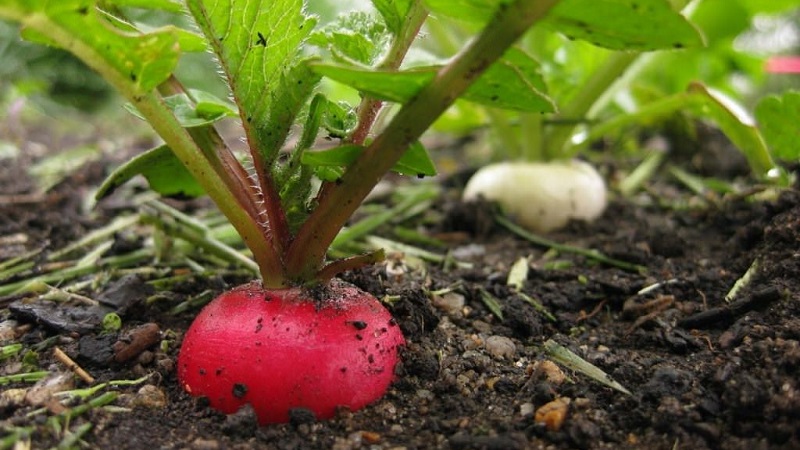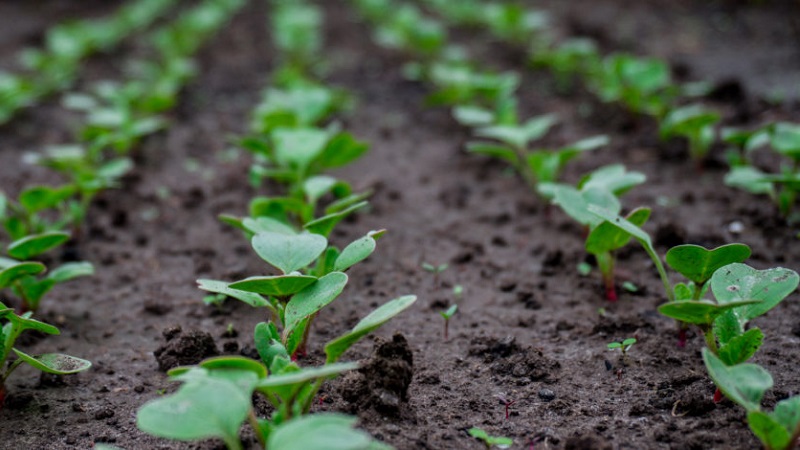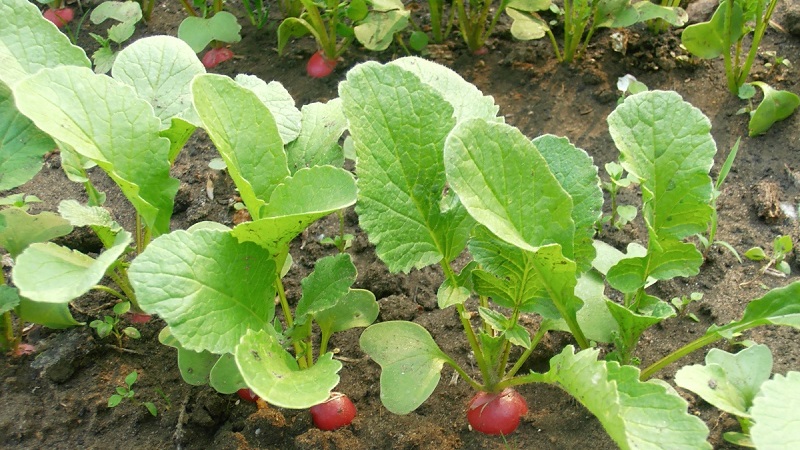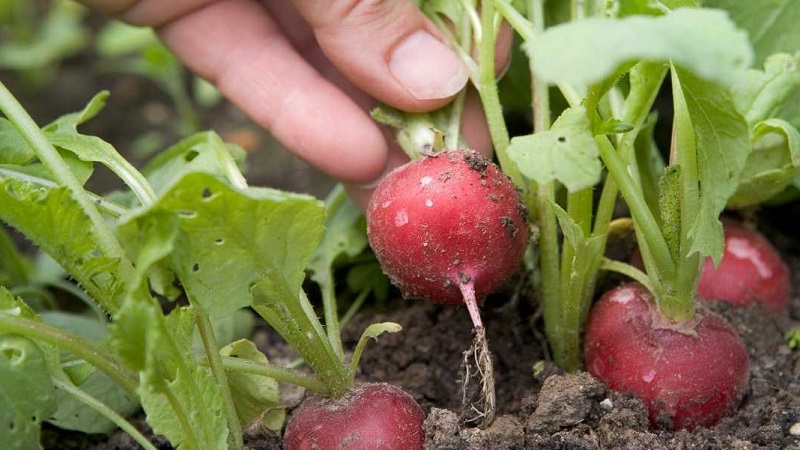Why radishes turn into color and how to grow them to prevent the problem
Radish is an unpretentious culture. But like all garden plants, it has its own growing characteristics. Radish is bitter or does not grow. Sometimes, instead of the formation of root crops, it goes into color, leaving the summer resident without a crop.
Why the root crop does not form and how to deal with the blooming of radish, we will analyze in detail in this article.
The content of the article
Why does radish turn into color, tops or arrow
Radish is considered a long day crop. For the formation of a root crop, they need at least 13 hours of daylight hours.if there is less light, the growth of the ground mass begins to accelerate, and the plant goes into color.

Although radish is considered an easy crop to grow, if the seeds are sown in unfavorable conditions, it will not yield a crop... The culture does not like too cold and too hot temperatures, the optimum temperature for planting is + 5 ... + 10 ° C, for cultivation + 15 ... + 18 ° C.
Why the fetus is not tied
There are several reasons why the radish goes into the arrow, and the formation of the fruit does not occur or slows down:
- Poor sowing timing... Radishes are sown in late March - early April, when the daylight hours are still short and the temperature does not exceed + 20 ° C.
- Wrong soil or a growing area. Radish grows well on loose sandy loam soils. Dislikes heavy soils.
- Insufficient watering in the process of growing. The culture is considered moisture-loving. It is recommended to water the radish every 2 days.
- Sowing seeds too thick... In order for root crops to have enough nutrients during cultivation, seeds are sown at a distance of 5 cm from each other.
Possible causes of problems
Optimal conditions for growing radishes - neutral sandy loam, moderately moist soils, temperature + 15 ... + 18 ° C, sufficient level of oxygen and minerals in the soil. The reasons that root crops are not formed are a violation of the agricultural technology of growing radish and mistakes made during sowing.
It can be useful:
Choosing the best radish fertilizer
Lack of moisture
The plant is hygrophilous. When sowing, the seeds are spread in moist soil and slightly compacted to increase the area of contact between the seeds and the moist soil.

After sowing, watered once every 1-2 days, then - once every 2-3 days... Better to do it in the evening. The roots grow up to 30 cm deep, so watering is necessary not only often, but also abundantly, so that the earth is moistened to the desired depth. If there is not enough water, the root crops do not receive the moisture they need for growth, and the plant throws all its strength into the growth of the tops and goes into the arrow.
Important! Radishes are grown in sunny areas well sheltered from the wind.
Lack of light
Radish is sensitive to light. With a lack of light, instead of a round root crop it grows elongated and an arrow forms soon. Excess light also makes it difficult to form a root crop. Therefore, it is recommended to sow radishes in early spring - early autumn, when daylight hours last no more than 10 hours.
Useful advice! When growing a root crop in the summer, the beds are shaded.
Late sowing
Late sowing of radish leads to an overabundance for the culture of heat and light, due to which the root crop will not form and will release the arrow.The best sowing dates are late March - early April and late July - August. Under these conditions, the daylight hours are still short, and the air temperature does not exceed + 20 ° C.

Fertilizer error
On soils poor in nutrients, the root crop will not be tied... But an overabundance of nutrients also harms the formation of radishes.
An excess of nitrogen fertilizers provokes a massive increase in green mass, while the roots do not develop. It is recommended to apply organic fertilizers one year before sowing the crop. Foliar dressing with the help of complex potassium-phosphorus fertilizers is also allowed.
Important! The soil should be fertilized, but without an excess of nitrogen.
Dense planting
 Another reason for a poor radish harvest is planting density. In order for the root crop to grow varietal sizes, the seedlings must have enough room for development... To do this, at the sowing stage, the seeds should be placed at a distance of 5 cm from each other.
Another reason for a poor radish harvest is planting density. In order for the root crop to grow varietal sizes, the seedlings must have enough room for development... To do this, at the sowing stage, the seeds should be placed at a distance of 5 cm from each other.
If the variety is chosen incorrectly, the culture does not adapt to the growing conditions and releases an arrow.
A poor-quality crop depends on the planting material. Carefully read the production date on the package, do not plant seeds with an expired shelf life. Pay attention to the size of the seeds - try to select only large and even ones.
Reference. Plants more often go into the arrow, if old and small seeds were used during sowing.
What to do
To prevent radishes from going into the arrow, follow the rules:
 Site selection and soil preparation... Choose a well-lit area with loose, nutrient-dense soil. It is advisable to prepare the soil in the fall, at the same time apply fertilizers.
Site selection and soil preparation... Choose a well-lit area with loose, nutrient-dense soil. It is advisable to prepare the soil in the fall, at the same time apply fertilizers.- Variety selection... Select and prepare seeds in advance for sowing. When choosing a variety, pay attention to the zoning and storage periods of seeds. When sowing, remove all small and diseased seeds.
- Sowing and care... When sowing, follow the established dates. The bed can be covered with a film to prevent hypothermia. After the first shoots appear, water and loosen the plants regularly.
- When growing radishes in a greenhouse ventilate the room constantly. Do not allow temperatures to exceed 22 ° C, adjust the length of daylight hours.
Read also:
How to grow radishes so that they don't fade
Agricultural technology for growing radish is as follows:
- Choosing a predecessor... Radish belongs to the cabbage family, so any crop not from this family is suitable as a predecessor.
- Site preparation... They begin to prepare the soil for sowing radish in the fall. Organic fertilizers are applied at the rate of 3-5 kg per 1 m2... Superphosphate and potash fertilizers are applied in the spring. If heavy clay soils prevail on the site, add sand and dig it up again in the spring.
- Seed preparation for sowing... It is important to calibrate the seeds before sowing. Use seeds with a diameter of at least 2.5 mm.
- Sowing is carried out in an ordinary way... The distance between the seeds is at least 5 cm. You can use the belt sowing method. To do this, glue is applied to a tape 5 cm wide and seeds are placed on it at the recommended distance, then the tape is laid in a row, lightly sprinkled with earth. Sow in moist soil in early spring.
- Crop care... Includes regular watering, especially in hot weather. If the seedlings have risen densely, thin out. Top dressing is undesirable. With an increase in the length of daylight hours, the radishes are shaded with a film. Weed and loosen the soil regularly.
- Harvested 18-45 days after sowing. The collection time depends on the variety.

How to prevent the abundance of tops
To prevent an abundance of green mass growth radish, it is recommended:
- choose the right predecessor;
- plant a crop in loose soil;
- do not grow radishes from small seeds;
- do not sow radishes too thickly;
- water in a timely manner;
- regulate the amount of light and heat.
Why are radishes bitter
Radish has a bitter taste in the following situations:
- lack of moisture - roots begin to taste bitter if irrigation is uneven and irregular;
- overripe fruits - if you do not remove the roots in time, they coarse, crack, dry from the inside and acquire a bitter taste;
- overgrowing of ridges with weeds;
- dense plantings;
- lack of oxygen.
What to do
To obtain juicy root vegetables with a pleasant pungency in taste that does not turn into bitterness, it is necessary to provide plants with high-quality and regular care:
- Thin out... Be sure to thin out the seedlings, leaving 3-5 cm between seedlings, otherwise the crop will be bitter, fibrous, dry and inedible.
- To water... The root crop needs regular watering, especially in hot weather. Without watering, it cracks and begins to taste bitter.
- Weed... Weeds deprive seedlings of water, light and nutrition.
- Loosen... After each rain and watering, loosen the aisles, otherwise the soil will be covered with a crust and the roots will not receive enough oxygen for normal development.
- Prevent overripe... Harvest the ripe crop in several steps, without leaving adult roots in the ground.

Experienced Farmer Tips
So that when growing radishes does not go to the arrowexperienced farmers recommend:
- choose varieties that are resistant to flowering;
- use purchased seeds from trusted manufacturers;
- plant radishes in soil with a neutral reaction, loose and moisture-consuming;
- do not plant densely, thin out crops;
- do not sow radishes deeper than 2 cm;
- water in moderation;
- mulch plantings with dry peat or humus.
Many summer residents prefer radish varieties Heat, Zarya, Soro, choosing according to photos and characteristics of the fruits on the packages.
The main pest of radish is the cruciferous flea... To combat it, it is recommended to cover the crops with the thinnest covering material and keep until 2-4 coarse leaves appear. The covering material does not interfere with the development of the plant, but fleas cannot reach it.
Conclusion
When grown, radishes most often turn into color due to a combination of factors, and not for one specific reason. To prevent this from happening, pay attention to the growing conditions of the crop, the correct care of the plants, experiment with seed. By creating optimal conditions for the plant, you will get a rich harvest.